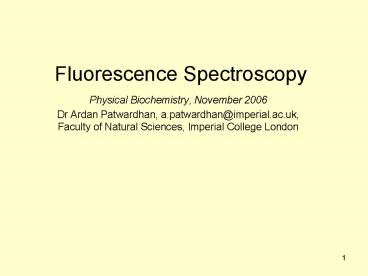Fluorescence Spectroscopy - PowerPoint PPT Presentation
1 / 25
Title:
Fluorescence Spectroscopy
Description:
... Anisotropy. Sample excited with linearly polarized light. Anisotropy, , of ... within the lifetime of the fluorophore will lead to a reduction in anisotropy ... – PowerPoint PPT presentation
Number of Views:726
Avg rating:5.0/5.0
Title: Fluorescence Spectroscopy
1
Fluorescence Spectroscopy
- Physical Biochemistry, November 2006
- Dr Ardan Patwardhan, a.patwardhan_at_imperial.ac.uk,
Faculty of Natural Sciences, Imperial College
London
2
Frank-Condon principle
- As the time-scale for an electronic transition is
much shorter than for vibrational transitions, it
can be assumed that inter nuclear distances will
not change during the transition - The transition most likely to occur is the one
for which the initial and excited wavefunctions
overlap the most
3
Fluorescence
- An excited molecule, e.g. in solution, may lose
its excess vibrational energy in collisions
(internal conversion) - As a consequence, the emitted photon has a longer
wavelength (lower energy) than the absorbed
photon - Usually requires flat rigid molecules with
extensive conjugation and delocalization
4
Phosphorescence
- A collision may cause an excited electron to flip
spin - This is know as an intersystem crossing and
leaves the molecule in a triplet state - Transitions from triplet to singlet states via
the emission of EMR are forbidden - The lifetime of the triplet state is very long
and can range from seconds to hours
5
Mirror symmetry of spectra
- Often, but not always present
- Thought to be due to the fact that if 0?n
vibration transition most likely on absorption,
then the same most likely on emission
6
Dynamics
- Solvent relaxation Solvent cage reorganizes
itself to better stabilize excited state ? energy
and lifetime of excited state may change - Difficult to define general rules for solvent
effects
7
Fluorescence parameters
- Quantum Efficiency Q.E. Emitted photons/
Absorbed photons - The Molar Extinction Coefficient, e (M-1cm-1) is
the absorbance of a 1 molar solution in a 1 cm
lightpath at a specified wavelength. - Brightness (sensitivity) Q.E x e
- Absorption and fluorescence spectra are
independent
8
Lifetime
- Fluorescence lifetime is the average time that an
electron spends in the excited state before a
photon is emitted - Measurement of the fluorescence from a large
number of molecules, following a short pulse
excitation, will show an exponential decay - The lifetime is given by the 1/e point of the
decay
9
Basic fluorescence spectrometer
- Source and detector at right angles
10
Quenching and photobleaching
- Photobleaching (fading) permanent loss of
fluorescence due to photo-induced chemical
modification of molecule - Quenching Competing processes that induce
non-radiative relaxation of excited-state
electrons to the ground state
11
Quenching as a tool to probe fluorophore
environment
- Requires contact between fluorophore and quencher
- Typical quenchers iodide, acrylamide and O2
12
Fluorescence Anisotropy
- Sample excited with linearly polarized light
- Anisotropy, , of the
resulting fluorescence measured - Reorientation of the molecule within the lifetime
of the fluorophore will lead to a reduction in
anisotropy
13
Fluorescence Recovery after Photo-bleaching (FRAP)
- Useful technique for studying transport
properties within a cell, especially
transmembrane protein diffusion - Label the molecule with a fluorophore
- Bleach (destroy) the fluorophore is a well
defined area with a high intensity laser - Use a weaker beam to examine the recovery of
fluorescence as a function of time - Nature Cell Biology 3, E145 - E147 (2001)
14
FRAP
- FRAP can be used to estimate the rate of
diffusion, and the fraction of molecules that are
mobile/immobile - Can also be used to distinguish between active
transport and diffusion
15
Fluorescence Resonance Energy Transfer (FRET)
- Non-radiative transfer of excited state energy
from donor molecule to acceptor molecule, i.e., a
form of quenching! - Donor and acceptor molecules must be in close
proximity (lt10nm) - Molecular dipoles must be somewhat oriented
- Absorption spectra of acceptor molecule must
overlap to some extent with the fluorescence
spectra of donor molecule
16
FRET contd
- FRET is very sensitive to the distance between
donor an acceptor and is therefore an extremely
useful tool for studying molecular dynamics - Efficiency ? R-6
17
Fluorescence correlation spectroscopy
- Method for observing fluorescence from single
molecules - Relies on a low concentration, a small
illuminated volume and a fast detector - Using the auto-correlation function simplifies
averaging over many measurements - Useful for molecular binding and aggregation
studies
18
Time-resolved Fluorescence Spectroscopy
- Short pulse excitation followed by an interval
during which the resulting fluorescence is
measured as a function of time - Lifetimes can be very sensitive to local
environment - Possibly linked to the refractive index of the
environment - Lifetime measurements are robust against
variation in intensity, i.e., an absolute
measurement
19
Intrinsic Fluorescence
- Fluorescence spectra lie in the UV region
- The spectra for both Tyr and Trp are extremely
sensitive to local environment
20
Solvent effects are useful for studying protein
folding
21
Fluorescein as a pH sensor
Only the monoanion and dianion are fluorescent
and the dianion fluorescence dominates!
22
Sodium and Potassium ion sensitive probes
Ligand pocket engineered to complex ion of
interest
23
Ca2 probes (R Tsien)
Ligand binding twists the lone pairs on the
Nitrogens out of conjugation with the ring
hypsochromic shift
BAPTA
24
Ca2 probes contd.
Quin
Fura-2
Conjugation increased to red-shift spectrum and
improve extinction coefficients and quantum yields
25
Main Points
- The fluorescence spectrum is shifted to longer
wavelengths compared with the absorption spectrum - Fluorescence spectroscopy allows in general more
sensitive measurements than absorption
spectroscopy - Both the fluorescence spectrum and the lifetime
are sensitive to the environment































